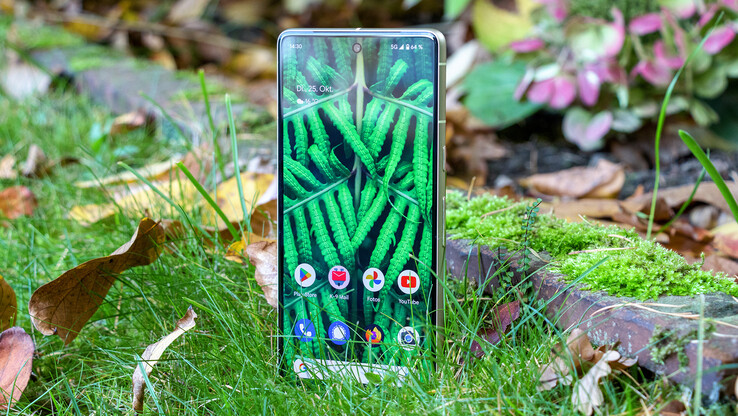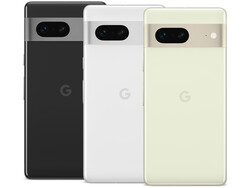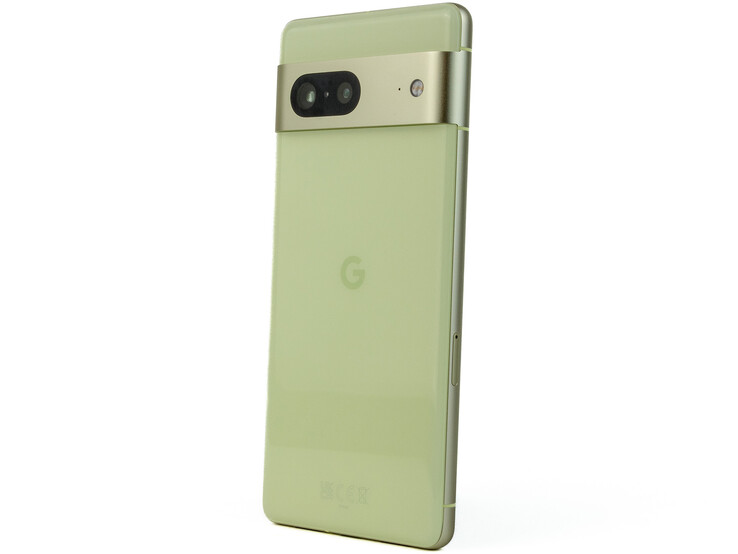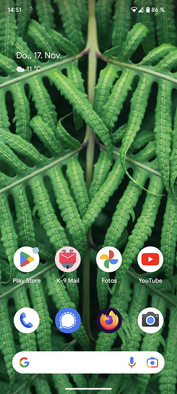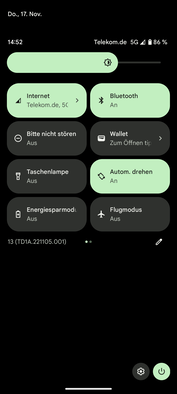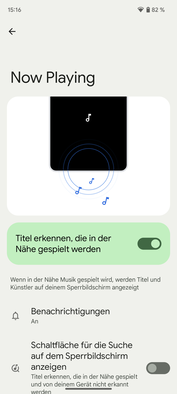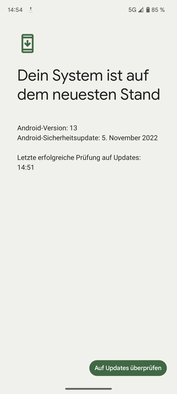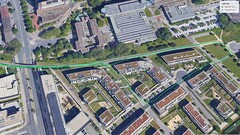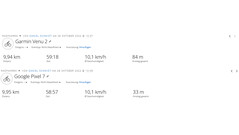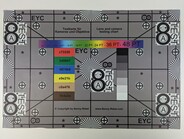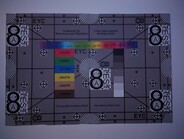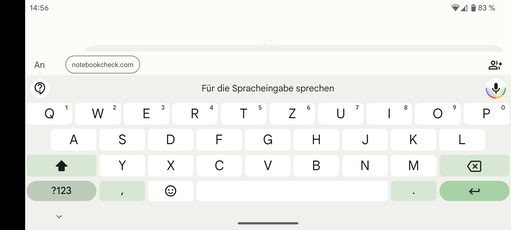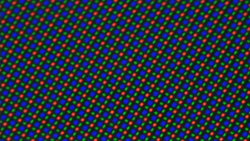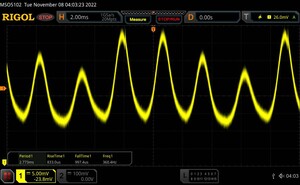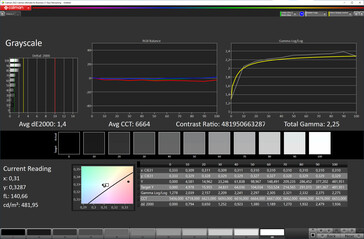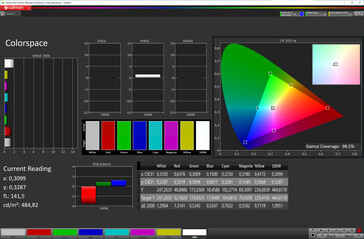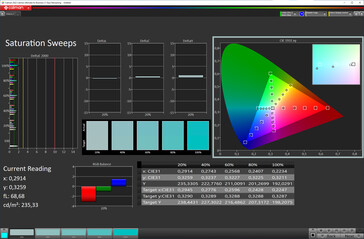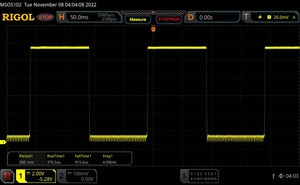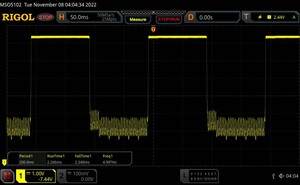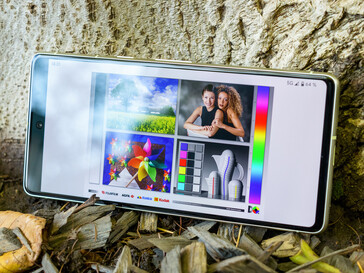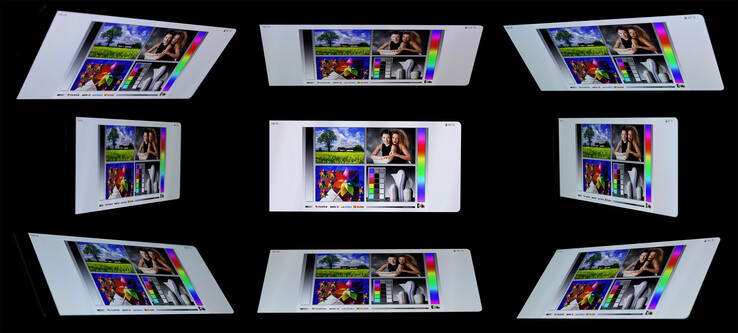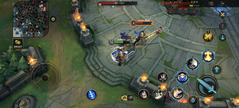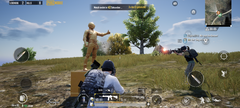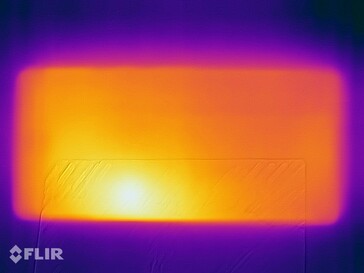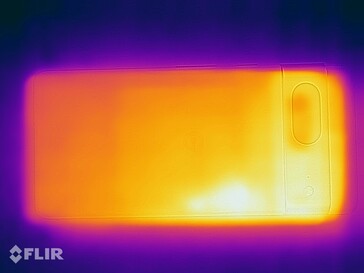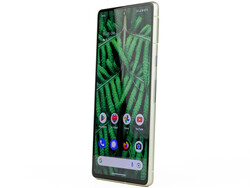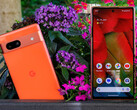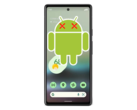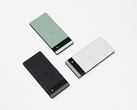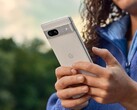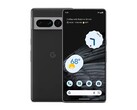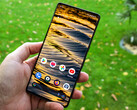Google Pixel 7 review - Compact Google smartphone without big trade-offs
With the Pixel 7, Google is not budging from last year's smartphone concept and with it they are offering a direct successor to the Pixel 6. Once again, the smartphone is somewhat more compact than the more expensive Pro model. That is reflected in the smaller display which also operates at a lower refresh rate. Apart from that, the Pixel 7 also has less RAM, has no optical zoom for its camera and has a smaller battery.
Regarding internal storage, Google has made positive strides. Although expansion via microSD card is still not possible, a 256 GB model can now also be purchased, costing an additional 100 euros ($103). The 128 GB base model can be had for 649 euros ($665).
Possible competitors compared
Rating | Date | Model | Weight | Drive | Size | Resolution | Best Price |
|---|---|---|---|---|---|---|---|
| 88.5 % | 11/2022 | Google Pixel 7 Tensor G2, Mali-G710 MP7 | 197 g | 128 GB UFS 3.1 Flash | 6.30" | 2400x1080 | |
| 89.2 % | 10/2022 | Apple iPhone 14 A15, A15 GPU 5-Core | 172 g | 128 GB NVMe | 6.10" | 2532x1170 | |
| 87.4 % | 10/2022 | Motorola Edge 30 Fusion SD 888+ 5G, Adreno 660 | 172 g | 128 GB UFS 3.1 Flash | 6.55" | 2400x1080 | |
| 87.4 % | 11/2021 | Google Pixel 6 Tensor, Mali-G78 MP20 | 207 g | 128 GB UFS 3.1 Flash | 6.40" | 2400x1080 | |
| 89.2 % | 12/2022 | Sony Xperia 5 IV SD 8 Gen 1, Adreno 730 | 171 g | 128 GB UFS 3.1 Flash | 6.10" | 2520x1080 | |
| 89.3 % | 05/2022 | Samsung Galaxy S22 Exynos 2200, Xclipse 920 | 167 g | 128 GB UFS 3.1 Flash | 6.10" | 2340x1080 |
Case - A smart mix of aluminum and glass for the Pixel 7
The Google Pixel 7 possesses a similar design to its predecessor, however, the camera bump is now made from a one-piece, matte aluminum frame which certainly enhances its looks. The smartphone is available in Obsidian (black), Snow (white) and Lemongrass color variants.
The smartphone doesn't wobble on flat surfaces due to the camera's wide cut-out but is tilted enough to go far a walk, even on slight inclines. This is mainly due to the smooth surface of the Corning Gorilla Glass Victus which adorns both the front and back of the device.
The Pixel 7 has good build quality with the smartphone making a high-quality impression as well as feeling good in the hand. Overall the device is well finished and is free of small gaps between the frame, front and rear sides. However, on our test device the rear side is not always even. Especially, where the glass transitions to aluminum. By comparison, the SIM slot sits flush to the frame.
The Pixel 7 battery is non-removable and cannot be replaced by the user. The smartphone has an IP68 rating for water and dust resistance.
Equipment - Pixel 7 has to do without UWB
As with its predecessor, the Google Pixel 7 lacks a headphone jack, an IR blaster, FM radio as well as memory expansion in the form of a microSD card. The latter is easier to accept now that a model with 256 GB of internal storage is available.
The Google Pixel 7 has a fast USB 3.2 port (2nd gen) which allows high data speeds and supports OTG but not wired video output. Bluetooth 5.2 and NFC are also included with UWB being a feature exclusive to the Pixel 7 Pro.
Software - Android smartphone with a long update cycle
The Pixel 7 ships with Android 13 and is likely to receive three version upgrades, including Android 16. Security patches will continue to be distributed for at least another two years after that. Google has provided further information on a corresponding page which you can find here.
Bloatware is nowhere to be seen on the Pixel 7 as only the company's own apps are preinstalled. Exclusive Pixel features such as Live Translation and Now Playing are also available. Plus, in December, the Pixel 7 will also receive free Google VPN.
Communication and GNSS - Sub 6GHz 5G and Wi-Fi 6E for the Pixel 7
The Google Pixel 7 supports all common mobile network standards, including Sub 6GHz 5G. Reception characteristics in urban areas are very good for both Deutsche Telekom and Vodafone.
Concerning Wi-Fi connectivity, the same problem exists as with the Pixel 7 Pro as the smartphone doesn't recognize our Asus ROG Rapture GT-AXE11000 reference router's 6GHz band. Surely this will be fixed via an update. As soon as this is the case, we will re-examine the corresponding measurement at a later date. However, we were able to achieve very high and stable transfer rates with WiFi 6 on the 5GHz frequency.
| Networking | |
| Google Pixel 7 | |
| iperf3 receive AXE11000 |
|
| iperf3 transmit AXE11000 |
|
| iperf3 transmit AXE11000 6GHz |
|
| iperf3 receive AXE11000 6GHz |
|
| Apple iPhone 14 | |
| iperf3 receive AXE11000 |
|
| iperf3 transmit AXE11000 |
|
| Motorola Edge 30 Fusion | |
| iperf3 receive AXE11000 |
|
| iperf3 transmit AXE11000 |
|
| iperf3 transmit AXE11000 6GHz |
|
| iperf3 receive AXE11000 6GHz |
|
| Google Pixel 6 | |
| iperf3 transmit AX12 |
|
| iperf3 receive AX12 |
|
| Sony Xperia 5 IV | |
| iperf3 receive AXE11000 |
|
| iperf3 transmit AXE11000 |
|
| iperf3 transmit AXE11000 6GHz |
|
| iperf3 receive AXE11000 6GHz |
|
| Samsung Galaxy S22 | |
| iperf3 receive AXE11000 |
|
| iperf3 transmit AXE11000 |
|
| Average of class Smartphone | |
| iperf3 receive AXE11000 |
|
| iperf3 transmit AXE11000 |
|
| iperf3 transmit AXE11000 6GHz |
|
| iperf3 receive AXE11000 6GHz |
|
| iperf3 receive AX12 |
|
The Google Pixel 7 uses dual-band GNSS to determine its position and supports all common networks. Outdoors, the satellite fix works very quickly and precisely. Indoors, it takes a little longer but also works accurately.
We compared the smartphone to the Garmin Venu 2 on a short bike tour. The determined route was nearly identical for both devices. Only a look at the detailed route log reveals the differences. While circling a lake, the Pixel recorded the covered route more accurately but the smartwatch was more precise when it came to the turning loop.
Telephone functions and call quality
The Google Pixel 7 is a dual-SIM smartphone which offers space for a physical nano-SIM as well as an eSIM. In March 2023, dual-eSIM support will be provided in the form of an update. Functions such as VoLTE and Wi-Fi calling are supported but not system-side SIP account control.
During testing, we were very pleased with the call quality and it is comparable to the level found on the Pixel 7 Pro. When held to the ear, the Pixel smartphone reproduces the user's voice very naturally. Small background noises are inaudible and filtered out without a loss in quality. The Pixel 7 even copes with busy environments in a satisfactory manner, although, very ocassionally, background noises as well as the user's voice can sound a lttle hollow. This effect is amplified in noisy environments.
Cameras - Attractive photos with Google's dual camera
The front camera is identical to the one found on the Pixel 7 Pro, delivering 10.8 MP with no autofocus. On the highest setting, videos can be recorded in UHD at up to 60fps. However, using the HDR function limits the framerate to 30fps. A large section can be captured using the wide-angle mode. In general, we are very pleased with daytime shots and in lowlight situations Night Sight mode can be activated.
In addition to the 50 MP main camera, Google has given the setup an additional ultra wide-angle 12 MP one on the rear of the device which is as good as identical to those found on the Pro models. This additional camera's coverage angle appears somewhat narrower at 114°. When it comes to recording quality, the difference is almost imperceptible and the Pixel 7's ultra wide angle also gets a little soft towards the edges.
The main camera enables particularly good shots, especially at close range. Subjects which are somewhat further away show a very high amount of background noise and there is a small reduction in the depth of field. Image magnifications are only done digitally. The smartphone reaches its limits at 8X zoom and the quality ranges from average to mixed. However, two to three-fold magnifictions still look quite good.
At best, videos are recorded in UHD at up to 60fps and can be protected from camera shake by various stabilization options. This often comes with limitations. Used for capturing fast moving images, the active mode is limited to Full HD. Although the cinema effect is available in 4K, it runs at a lower framerate.
Image Comparison
Choose a scene and navigate within the first image. One click changes the position on touchscreens. One click on the zoomed-in image opens the original in a new window. The first image shows the scaled photograph of the test device.
HauptkameraHauptkameraUltraweitwinkel5-facher ZoomLow-LightWe took a closer look at the Pixel 7's dual camera under controlled lighting conditions. The colors are captured very naturally, with only the blue tones - especially cyan - deviating slightly.
The test chart was captured with a warm white balance but, in spite of this, the details remained intact right up to the edges.
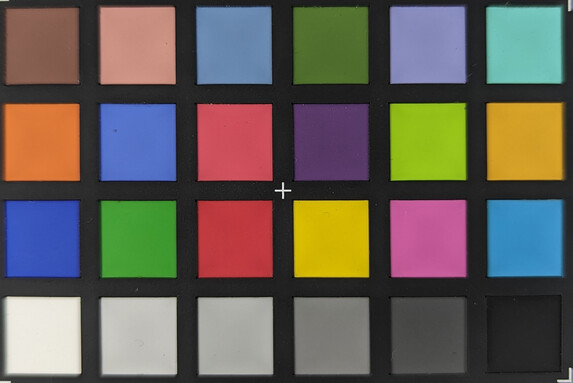
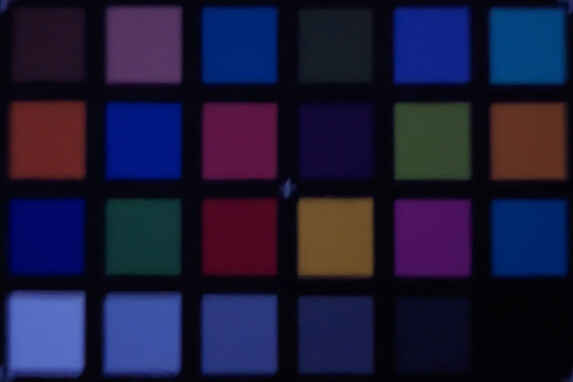
Accessories and guarantee - Pixel 7 once again without a charger
The Google Pixel 7 comes complete wth a USB-C cable and an OTG adapter (Type-C to Type-A). A suitable charger purchased directly from Google will set you back an additional 29 euros. A wireless charging dock, the Pixel Stand, is also available but will set you back 79 euros. Additionally, Google also offers protective phone cases for its smartphone which are available for 22 euros each.
The guarantee in Germany is for 24 months and cannot be extended.
Input devices & operation - now also with face recognition
The Pixel 7's touchscreen is protected by Corning Gorilla Glass and is wonderfully smooth to the touch. The touch sensitive surface recognizes up to ten simultaneous inputs and is implemented precisely.
In the area of biometric security, an optical fingerprint scanner is once again built into the display. It is relatively small but appears to be more responsive than its predecessor. Many users' complaints have been listened to regarding the Pixel 6's sensor leading to calls for the implementation of face recognition technology. Google listened and has introduced such a feature via the front camera. This is not as safe as the 3D face recognition found in the Pixel 4, but is convenient.
The vibration motor delivers solid feeback and feels great in the hand. The full scope of accessibilty features and gestures described in the Pixel 7 Pro review are also available for the Pixel 7.
Display - Google smartphone with a bright 90Hz OLED
The Google Pixel 7 OLED display measures 6.3 inches (16 cm). With Full HD Plus resolution, the panel used here is very sharp. Unlike the Pro model Google didn't implement an LTPO panel. With the Smooth Display function activated, the system automatically switches between 60 and 90Hz. Alternatively, the smartphone can be operated at a locked 60fps. Common HDR standards (HLG, HDR10, HDR10+) are supported.
The luminosity can described as average, reaching a high of 947 cd/m² with the ambient light sensor activated and a full-surface pure white image displayed. We were able to measure up to 1262 cd/m² with an even distribution of light and dark areas (APL18). When the brightness is set to manual, a maximum of 480 cd/m² is possible.
At minimum brightness the OLED display flickers in quite a pronounced, irregular, periodic manner and fluctuates between 90 and 360Hz. This increases the likelihood of complaints from users who are sensitive to such issues. However, we were unable to detect any temporal dithering. To achieve this, we looked at the display through a microscope using 240fps slow motion video (dark gray, at maximum brightness).
| |||||||||||||||||||||||||
Brightness Distribution: 95 %
Center on Battery: 936 cd/m²
Contrast: ∞:1 (Black: 0 cd/m²)
ΔE Color 1.3 | 0.5-29.43 Ø5
ΔE Greyscale 1.4 | 0.57-98 Ø5.3
98.5% sRGB (Calman 2D)
Gamma: 2.25
| Google Pixel 7 OLED, 2400x1080, 6.30 | Apple iPhone 14 OLED, 2532x1170, 6.10 | Motorola Edge 30 Fusion pOLED, 2400x1080, 6.55 | Google Pixel 6 OLED, 2400x1080, 6.40 | Sony Xperia 5 IV OLED, 2520x1080, 6.10 | Samsung Galaxy S22 AMOLED, 2340x1080, 6.10 | |
|---|---|---|---|---|---|---|
| Screen | -15% | -5% | -17% | -32% | -20% | |
| Brightness middle | 936 | 835 -11% | 954 2% | 805 -14% | 896 -4% | 853 -9% |
| Brightness | 947 | 841 -11% | 961 1% | 805 -15% | 902 -5% | 858 -9% |
| Brightness Distribution | 95 | 97 2% | 98 3% | 98 3% | 97 2% | 96 1% |
| Black Level * | ||||||
| Colorchecker dE 2000 * | 1.3 | 1.05 19% | 1.5 -15% | 1.4 -8% | 2 -54% | 1.9 -46% |
| Colorchecker dE 2000 max. * | 2.7 | 2.81 -4% | 2.5 7% | 3.7 -37% | 6.4 -137% | 3.2 -19% |
| Greyscale dE 2000 * | 1.4 | 2.6 -86% | 1.8 -29% | 1.8 -29% | 1.3 7% | 1.9 -36% |
| Gamma | 2.25 98% | 2.034 108% | 2.24 98% | 2.29 96% | 2.25 98% | 2.07 106% |
| CCT | 6664 98% | 6616 98% | 6254 104% | 6507 100% | 6618 98% | 6460 101% |
* ... smaller is better
Screen Flickering / PWM (Pulse-Width Modulation)
| Screen flickering / PWM detected | 360 Hz | ||
The display backlight flickers at 360 Hz (worst case, e.g., utilizing PWM) . The frequency of 360 Hz is relatively high, so most users sensitive to PWM should not notice any flickering. However, there are reports that some users are still sensitive to PWM at 500 Hz and above, so be aware. In comparison: 53 % of all tested devices do not use PWM to dim the display. If PWM was detected, an average of 17909 (minimum: 5 - maximum: 3846000) Hz was measured. | |||
Measurements with fixed zoom and different brightness settings
The Google Pixel 7 achieves its most balanced color reproduction when the color profile Natural is selected in the settings. To the human eye, colors are reproduced without noticable deviations. A slight green tint is only discernible at very bright gray scales.
Display Response Times
| ↔ Response Time Black to White | ||
|---|---|---|
| 1.89 ms ... rise ↗ and fall ↘ combined | ↗ 0.9765 ms rise | |
| ↘ 0.915 ms fall | ||
| The screen shows very fast response rates in our tests and should be very well suited for fast-paced gaming. In comparison, all tested devices range from 0.1 (minimum) to 240 (maximum) ms. » 5 % of all devices are better. This means that the measured response time is better than the average of all tested devices (21.5 ms). | ||
| ↔ Response Time 50% Grey to 80% Grey | ||
| 4.61 ms ... rise ↗ and fall ↘ combined | ↗ 2.266 ms rise | |
| ↘ 2.34 ms fall | ||
| The screen shows very fast response rates in our tests and should be very well suited for fast-paced gaming. In comparison, all tested devices range from 0.2 (minimum) to 636 (maximum) ms. » 11 % of all devices are better. This means that the measured response time is better than the average of all tested devices (33.7 ms). | ||
Performance - The Tensor G2 works hard in the Pixel 7
For the Pixel 7, Google relies on the second generation of its in-house chipset, the Tensor G2. This is supported by 8 GB of LPDDR5 RAM. On paper, the marginally high-end SoC is similar to its predecessor and is also manufactured at five nanometers. Performance gains are correspondingly small in the area of CPU performance.
By comparison, AI acceleration fares much better as a performance increase of up to 50 percent can be found here. Although the Tensor G2 is a very fast SoC, it comes last when compared to the competition but still allows for very smooth system navigation.
| UL Procyon AI Inference for Android - Overall Score NNAPI | |
| Sony Xperia 5 IV | |
| Google Pixel 7 | |
| Average Google Tensor G2 (37656 - 44323, n=5) | |
| Motorola Edge 30 Fusion | |
| Google Pixel 6 | |
| Average of class Smartphone (207 - 84787, n=150, last 2 years) | |
| AImark - Score v2.x | |
| Average of class Smartphone (1043 - 139804, n=50, last 2 years) | |
| Samsung Galaxy S22 | |
| Google Pixel 7 | |
| Average Google Tensor G2 (5976 - 6131, n=2) | |
| Google Pixel 6 | |
| Sony Xperia 5 IV | |
In benchmarking with the OpenGL ES 3.2 API, the graphics chip - an ARM Mali-G710 MP7 - shows big increases in performance compared to the Mali-G78 MP20. Regarding the Vulkan API, this looks somewhat different. Occasionally, the older GPU even has the edge. In this regard, Google will probably have to improve its drivers.
GFXBench (DX / GLBenchmark) 2.7: T-Rex Onscreen | 1920x1080 T-Rex Offscreen
GFXBench 3.0: on screen Manhattan Onscreen OGL | 1920x1080 1080p Manhattan Offscreen
GFXBench 3.1: on screen Manhattan ES 3.1 Onscreen | 1920x1080 Manhattan ES 3.1 Offscreen
GFXBench: on screen Car Chase Onscreen | 1920x1080 Car Chase Offscreen | on screen Aztec Ruins High Tier Onscreen | 2560x1440 Aztec Ruins High Tier Offscreen | on screen Aztec Ruins Normal Tier Onscreen | 1920x1080 Aztec Ruins Normal Tier Offscreen
| 3DMark / Wild Life Extreme Unlimited | |
| Apple iPhone 14 | |
| Sony Xperia 5 IV | |
| Samsung Galaxy S22 | |
| Google Pixel 6 | |
| Google Pixel 7 | |
| Motorola Edge 30 Fusion | |
| 3DMark / Wild Life Extreme | |
| Apple iPhone 14 | |
| Sony Xperia 5 IV | |
| Google Pixel 6 | |
| Samsung Galaxy S22 | |
| Google Pixel 7 | |
| Motorola Edge 30 Fusion | |
| 3DMark / Wild Life Unlimited Score | |
| Apple iPhone 14 | |
| Sony Xperia 5 IV | |
| Samsung Galaxy S22 | |
| Google Pixel 6 | |
| Google Pixel 7 | |
| Motorola Edge 30 Fusion | |
| 3DMark / Wild Life Score | |
| Sony Xperia 5 IV | |
| Samsung Galaxy S22 | |
| Google Pixel 6 | |
| Google Pixel 7 | |
| Motorola Edge 30 Fusion | |
| Apple iPhone 14 | |
| 3DMark / Sling Shot Extreme (Vulkan) Unlimited Physics | |
| Samsung Galaxy S22 | |
| Apple iPhone 14 | |
| 3DMark / Sling Shot Extreme (Vulkan) Unlimited Graphics | |
| Samsung Galaxy S22 | |
| Apple iPhone 14 | |
| 3DMark / Sling Shot Extreme (Vulkan) Unlimited | |
| Samsung Galaxy S22 | |
| Apple iPhone 14 | |
| 3DMark / Sling Shot Extreme (ES 3.1) Unlimited Physics | |
| Motorola Edge 30 Fusion | |
| Google Pixel 7 | |
| Sony Xperia 5 IV | |
| Samsung Galaxy S22 | |
| Google Pixel 6 | |
| Apple iPhone 14 | |
| 3DMark / Sling Shot Extreme (ES 3.1) Unlimited Graphics | |
| Sony Xperia 5 IV | |
| Samsung Galaxy S22 | |
| Google Pixel 7 | |
| Motorola Edge 30 Fusion | |
| Google Pixel 6 | |
| Apple iPhone 14 | |
| 3DMark / Sling Shot Extreme (ES 3.1) Unlimited | |
| Sony Xperia 5 IV | |
| Motorola Edge 30 Fusion | |
| Samsung Galaxy S22 | |
| Google Pixel 7 | |
| Google Pixel 6 | |
| Apple iPhone 14 | |
| 3DMark / Sling Shot Extreme (ES 3.1) | |
| Samsung Galaxy S22 | |
| Apple iPhone 14 | |
| 3DMark / Sling Shot Extreme (ES 3.1) Graphics | |
| Samsung Galaxy S22 | |
| Apple iPhone 14 | |
| 3DMark / Sling Shot Extreme (ES 3.1) Physics | |
| Samsung Galaxy S22 | |
| Apple iPhone 14 | |
| GFXBench (DX / GLBenchmark) 2.7 / T-Rex Onscreen | |
| Samsung Galaxy S22 | |
| Google Pixel 6 | |
| Google Pixel 7 | |
| Sony Xperia 5 IV | |
| Apple iPhone 14 | |
| GFXBench (DX / GLBenchmark) 2.7 / T-Rex Offscreen | |
| Apple iPhone 14 | |
| Sony Xperia 5 IV | |
| Samsung Galaxy S22 | |
| Google Pixel 7 | |
| Google Pixel 6 | |
| GFXBench 3.0 / Manhattan Onscreen OGL | |
| Motorola Edge 30 Fusion | |
| Samsung Galaxy S22 | |
| Google Pixel 7 | |
| Google Pixel 6 | |
| Sony Xperia 5 IV | |
| Apple iPhone 14 | |
| GFXBench 3.0 / 1080p Manhattan Offscreen | |
| Apple iPhone 14 | |
| Samsung Galaxy S22 | |
| Sony Xperia 5 IV | |
| Motorola Edge 30 Fusion | |
| Google Pixel 7 | |
| Google Pixel 6 | |
| GFXBench 3.1 / Manhattan ES 3.1 Onscreen | |
| Samsung Galaxy S22 | |
| Motorola Edge 30 Fusion | |
| Google Pixel 7 | |
| Sony Xperia 5 IV | |
| Apple iPhone 14 | |
| Google Pixel 6 | |
| GFXBench 3.1 / Manhattan ES 3.1 Offscreen | |
| Apple iPhone 14 | |
| Samsung Galaxy S22 | |
| Sony Xperia 5 IV | |
| Motorola Edge 30 Fusion | |
| Google Pixel 7 | |
| Google Pixel 6 | |
| GFXBench / Car Chase Onscreen | |
| Google Pixel 7 | |
| Samsung Galaxy S22 | |
| Apple iPhone 14 | |
| Motorola Edge 30 Fusion | |
| Sony Xperia 5 IV | |
| Google Pixel 6 | |
| GFXBench / Car Chase Offscreen | |
| Apple iPhone 14 | |
| Google Pixel 7 | |
| Samsung Galaxy S22 | |
| Sony Xperia 5 IV | |
| Motorola Edge 30 Fusion | |
| Google Pixel 6 | |
| GFXBench / Aztec Ruins High Tier Onscreen | |
| Apple iPhone 14 | |
| Samsung Galaxy S22 | |
| Google Pixel 7 | |
| Sony Xperia 5 IV | |
| Google Pixel 6 | |
| Motorola Edge 30 Fusion | |
| GFXBench / Aztec Ruins High Tier Offscreen | |
| Apple iPhone 14 | |
| Google Pixel 7 | |
| Samsung Galaxy S22 | |
| Sony Xperia 5 IV | |
| Motorola Edge 30 Fusion | |
| Google Pixel 6 | |
| GFXBench / Aztec Ruins Normal Tier Onscreen | |
| Samsung Galaxy S22 | |
| Google Pixel 7 | |
| Apple iPhone 14 | |
| Motorola Edge 30 Fusion | |
| Sony Xperia 5 IV | |
| Google Pixel 6 | |
| GFXBench / Aztec Ruins Normal Tier Offscreen | |
| Apple iPhone 14 | |
| Sony Xperia 5 IV | |
| Google Pixel 7 | |
| Samsung Galaxy S22 | |
| Motorola Edge 30 Fusion | |
| Google Pixel 6 | |
Surfing the web is a smooth experience on the Google Pixel 7. Compared to the competition, the smartphone finds itself in the middle of the pack with results only being quite low in WebXPRT tests. In this case, this is due to Chrome as Microsoft's Edge achieves more points in testing.
| Jetstream 2 - Total Score | |
| Apple iPhone 14 (Safari 16) | |
| Sony Xperia 5 IV (chrome 107) | |
| Average of class Smartphone (13.8 - 351, n=173, last 2 years) | |
| Average Google Tensor G2 (96.3 - 117.8, n=5) | |
| Motorola Edge 30 Fusion (Chrome 105) | |
| Samsung Galaxy S22 (Chrome 100.0.4896.79) | |
| Google Pixel 7 (Chrome 106) | |
| Google Pixel 6 (Chrome 96) | |
| Speedometer 2.0 - Result | |
| Apple iPhone 14 (Safari 16) | |
| Average Google Tensor G2 (100 - 134, n=5) | |
| Samsung Galaxy S22 (Chrome 100.0.4896.79) | |
| Average of class Smartphone (14.9 - 445, n=157, last 2 years) | |
| Google Pixel 6 (Chrome 96) | |
| Google Pixel 7 (Chrome 106) | |
| Sony Xperia 5 IV (Chrome 107) | |
| WebXPRT 4 - Overall | |
| Apple iPhone 14 (Safari 16) | |
| Sony Xperia 5 IV (Chrome 107) | |
| Motorola Edge 30 Fusion (Chrome 105) | |
| Average of class Smartphone (22 - 202, n=160, last 2 years) | |
| Average Google Tensor G2 (90 - 111, n=5) | |
| Google Pixel 7 (Chrome 106) | |
| WebXPRT 3 - Overall | |
| Apple iPhone 14 (Safari 16) | |
| Sony Xperia 5 IV (Chrome 107) | |
| Samsung Galaxy S22 (Chrome 100.0.4896.79) | |
| Average of class Smartphone (39 - 304, n=122, last 2 years) | |
| Google Pixel 6 (Chrome 96) | |
| Average Google Tensor G2 (98 - 134, n=3) | |
| Google Pixel 7 (Chrome 106) | |
| Octane V2 - Total Score | |
| Apple iPhone 14 (Safari 16) | |
| Sony Xperia 5 IV (Chrome 107) | |
| Average Google Tensor G2 (43817 - 47939, n=5) | |
| Google Pixel 7 | |
| Google Pixel 6 (Chrome 96) | |
| Samsung Galaxy S22 (Chrome 100.0.4896.79) | |
| Motorola Edge 30 Fusion (Chrome 105) | |
| Average of class Smartphone (4633 - 89112, n=211, last 2 years) | |
| Mozilla Kraken 1.1 - Total | |
| Average of class Smartphone (388 - 9999, n=173, last 2 years) | |
| Samsung Galaxy S22 (Chrome 100.0.4896.79) | |
| Motorola Edge 30 Fusion (Chrome 105) | |
| Google Pixel 6 (Chrome 96) | |
| Google Pixel 7 (Chrome 106) | |
| Average Google Tensor G2 (920 - 1075, n=5) | |
| Sony Xperia 5 IV | |
| Apple iPhone 14 (Safari 16) | |
* ... smaller is better
In most areas, the UFS 3.1 storage's speed has been greatly improved upon over its predecessor with only sequential read being slower on the Pixel 7. Although it takes last place in this category compared to the competition, it's highly unlikely this is even noticeable during everyday use.
| Google Pixel 7 | Motorola Edge 30 Fusion | Google Pixel 6 | Sony Xperia 5 IV | Samsung Galaxy S22 | Average 128 GB UFS 3.1 Flash | Average of class Smartphone | |
|---|---|---|---|---|---|---|---|
| AndroBench 3-5 | 13% | -29% | 7% | 15% | 6% | 17% | |
| Sequential Read 256KB | 1280.81 | 1870.18 46% | 1546 21% | 1474 15% | 1486 16% | 1599 ? 25% | 1505 ? 18% |
| Sequential Write 256KB | 879.39 | 689.24 -22% | 233.4 -73% | 997 13% | 993 13% | 777 ? -12% | 1112 ? 26% |
| Random Read 4KB | 210.47 | 248.86 18% | 126.2 -40% | 207 -2% | 273 30% | 244 ? 16% | 247 ? 17% |
| Random Write 4KB | 253.92 | 276.74 9% | 190.3 -25% | 254 0% | 257.6 1% | 245 ? -4% | 271 ? 7% |
Gaming - Many titles play smoothly
The ARM Mali-G710 MP7 is a graphics powerhouse but Google puts the brakes on its potential (up to 16 cores). The Tensor G2 is equipped with a weaker GPU than MediaTek offers with the Dimensity 9000+ which has a G710 MP10. Nevertheless, enough performance is on hand to be able to enjoy almost every game, in its glory.
Using GameBench we were able to analyse a few games more closely. PUBG Mobile ran at a very consistent 40 (Ultra Setting) to 60fps (HD Setting) and also Wild Rift showed no framerate drops. Although the latter is limited to 60fps, it is able to support up to 120fps. Undemanding games such as Battle Bay are also able to take advantage of the 90Hz display's potential.
While testing the Pixel 7 Pro, we also tried Genshin Impact. Either the details or framerate had to be reduced in order to run this demanding game smoothly.
Emissions - The Google phone gets quite warm
Temperature
Although even at maximum display brightness, the Google Pixel 7's surface temperatures remain pleasantly low while idling, they increase up to 43.2 °C under continuous load. This is comparatively high but otherwise harmless.
It also gets quite hot inside Google's smartphone. The 3DMark Wild Life (Extreme) stress test showed a reduction in performance of up to 34 percent. That is not inconsiderable but the Pixel 7's long-term performance still compares more favorably to that of the Galaxy S22 which possesses a marginally faster SoC.
(±) The maximum temperature on the upper side is 43.2 °C / 110 F, compared to the average of 35 °C / 95 F, ranging from 21.9 to 56 °C for the class Smartphone.
(+) The bottom heats up to a maximum of 39.5 °C / 103 F, compared to the average of 33.8 °C / 93 F
(+) In idle usage, the average temperature for the upper side is 28.2 °C / 83 F, compared to the device average of 32.7 °C / 91 F.
3DMark Wild Life stress test
| 3DMark | |
| Wild Life Stress Test Stability | |
| Apple iPhone 14 | |
| Motorola Edge 30 Fusion | |
| Google Pixel 7 | |
| Sony Xperia 5 IV | |
| Samsung Galaxy S22 | |
| Google Pixel 6 | |
| Wild Life Extreme Stress Test | |
| Motorola Edge 30 Fusion | |
| Apple iPhone 14 | |
| Google Pixel 7 | |
| Sony Xperia 5 IV | |
| Samsung Galaxy S22 | |
| Google Pixel 6 | |
Speakers
The Pixel 7's moderately loud speakers create a pleasing sound at medium volumes. Unfortunately, the louder it gets, the more noticeable it becomes that the lower mids aren't very present. Accordingly, the sound lacks depth.
Wired headphones or speakers can be connected via the USB-C port. As a wireless option, Bluetooth 5.2 is available and only supports the most common audio codecs (SBC, AAC, aptX, aptX HD, LDAC).
Google Pixel 7 audio analysis
(+) | speakers can play relatively loud (88.3 dB)
Bass 100 - 315 Hz
(-) | nearly no bass - on average 27.4% lower than median
(±) | linearity of bass is average (9.5% delta to prev. frequency)
Mids 400 - 2000 Hz
(+) | balanced mids - only 3.9% away from median
(+) | mids are linear (5.6% delta to prev. frequency)
Highs 2 - 16 kHz
(±) | higher highs - on average 6.1% higher than median
(+) | highs are linear (3.9% delta to prev. frequency)
Overall 100 - 16.000 Hz
(±) | linearity of overall sound is average (18.1% difference to median)
Compared to same class
» 11% of all tested devices in this class were better, 8% similar, 81% worse
» The best had a delta of 12%, average was 38%, worst was 134%
Compared to all devices tested
» 33% of all tested devices were better, 8% similar, 59% worse
» The best had a delta of 4%, average was 25%, worst was 134%
Samsung Galaxy S22 audio analysis
(+) | speakers can play relatively loud (89.5 dB)
Bass 100 - 315 Hz
(-) | nearly no bass - on average 26.3% lower than median
(±) | linearity of bass is average (10.2% delta to prev. frequency)
Mids 400 - 2000 Hz
(±) | higher mids - on average 6.2% higher than median
(+) | mids are linear (4.4% delta to prev. frequency)
Highs 2 - 16 kHz
(±) | higher highs - on average 5.6% higher than median
(+) | highs are linear (5.5% delta to prev. frequency)
Overall 100 - 16.000 Hz
(±) | linearity of overall sound is average (19% difference to median)
Compared to same class
» 18% of all tested devices in this class were better, 9% similar, 73% worse
» The best had a delta of 12%, average was 38%, worst was 134%
Compared to all devices tested
» 39% of all tested devices were better, 8% similar, 53% worse
» The best had a delta of 4%, average was 25%, worst was 134%
Battery life - The Pixel 7 has a 4355 mAh battery
Power consumption
The Google Pixel 7's power consumption is very low and gave us no cause for criticism.
Due to the absent charger, care should be taken to use one which supports USB PD 3.0. Alternatively, it is possible to purchase an optional 30W charger from Google. Using this, the smartphone can be charged to 50 percent within 30 minutes.
Wireless charging is just as useable as reverse wireless charging. The former is possible up to 12W and Google Pixel Stand (2nd gen) owners can even charge the Pixel at up to 20W.
| Off / Standby | |
| Idle | |
| Load |
|
| Google Pixel 7 4355 mAh | Apple iPhone 14 3279 mAh | Motorola Edge 30 Fusion 4400 mAh | Google Pixel 6 4614 mAh | Sony Xperia 5 IV 5000 mAh | Samsung Galaxy S22 3700 mAh | Average Google Tensor G2 | Average of class Smartphone | |
|---|---|---|---|---|---|---|---|---|
| Power Consumption | -11% | -21% | -17% | -9% | -34% | -70% | -39% | |
| Idle Minimum * | 0.89 | 0.6 33% | 0.83 7% | 0.68 24% | 0.7 21% | 0.69 22% | 0.896 ? -1% | 0.897 ? -1% |
| Idle Average * | 1.07 | 0.8 25% | 1.72 -61% | 1 7% | 1.04 3% | 1.19 -11% | 1.984 ? -85% | 1.452 ? -36% |
| Idle Maximum * | 1.2 | 1 17% | 1.75 -46% | 1.02 15% | 1.15 4% | 1.26 -5% | 2.07 ? -73% | 1.629 ? -36% |
| Load Average * | 3.27 | 5.4 -65% | 2.76 16% | 5.39 -65% | 4.25 -30% | 6.97 -113% | 6.32 ? -93% | 5.55 ? -70% |
| Load Maximum * | 5.5 | 9.2 -67% | 6.74 -23% | 9 -64% | 7.84 -43% | 8.85 -61% | 10.8 ? -96% | 8.31 ? -51% |
* ... smaller is better
Power consumption: Geekbench (150 cd/m²)
Power consumption: GFXBench (150 cd/m²)
Battery life
In actual fact, the Pixel 7 has very good battery life. However, this was surprisingly low during the reader’s test which simulates reading a book using the browser at minimum display brightness. That can likely be traced back to the Wi-Fi module's higher consumption. No doubt Google will have to make improvements in this area with one or two updates.
| Google Pixel 7 4355 mAh | Google Pixel 6 4614 mAh | Samsung Galaxy S22 3700 mAh | Apple iPhone 14 3279 mAh | Motorola Edge 30 Fusion 4400 mAh | |
|---|---|---|---|---|---|
| Battery Runtime | 18% | 19% | 48% | -6% | |
| Reader / Idle | 1063 | 2020 90% | 2182 105% | 2689 153% | |
| H.264 | 1230 | 1219 -1% | 887 -28% | 1266 3% | |
| WiFi v1.3 | 731 | 627 -14% | 675 -8% | 1010 38% | 686 -6% |
| Load | 302 | 291 -4% | 324 7% | 289 -4% |
Pros
Cons
Verdict - The Pixel 7 is excellent value for money
The Pixel 7 skilfully builds on its predecessor and stays focussed on being a powerful smartphone at a comparatively low price. This extends from the fast SoC, the very bright and color accurate OLED display all the way to the powerful dual camera. Google is able to round this off with good battery life as well as long-term updates. In addition, they even provide a free VPN from Google One.
However, that's not all. On the plus side, there is also wide mobile frequency coverage, including 5G, IP68 certification as well as wireless charging. Although there's still no microSD expansion slot, an optional 256 GB model is available to purchase.
The Google Pixel 7 is an attractive proposition with a good dual camera and at least five years of updates.
However, some compromises had to be made. In particular, the Pixel 7's display still has a lot of potential for the upcoming Pixel 8 as its current refresh rate sits at 90Hz and it's not of the LTPO kind. On top of that, Google could have paid similar attention to PWM management as they did with the Pixel 7 Pro. In addition, UWB is not included and the ultrawide angle camera has to make do without a macro mode.
Good alternatives in this price segment are the Samsung Galaxy S22 as well as the Motorola Edge 30 Fusion. The iPhone 14's concept is similar but is 350 euros more expensive.
Price and availability
The Pixel 7 is available directly from the Google Store or alternatively on Amazon.
Google Pixel 7
-
11/18/2022 v7
Daniel Schmidt


 Deutsch
Deutsch English
English Español
Español Français
Français Italiano
Italiano Nederlands
Nederlands Polski
Polski Português
Português Русский
Русский Türkçe
Türkçe Svenska
Svenska Chinese
Chinese Magyar
Magyar